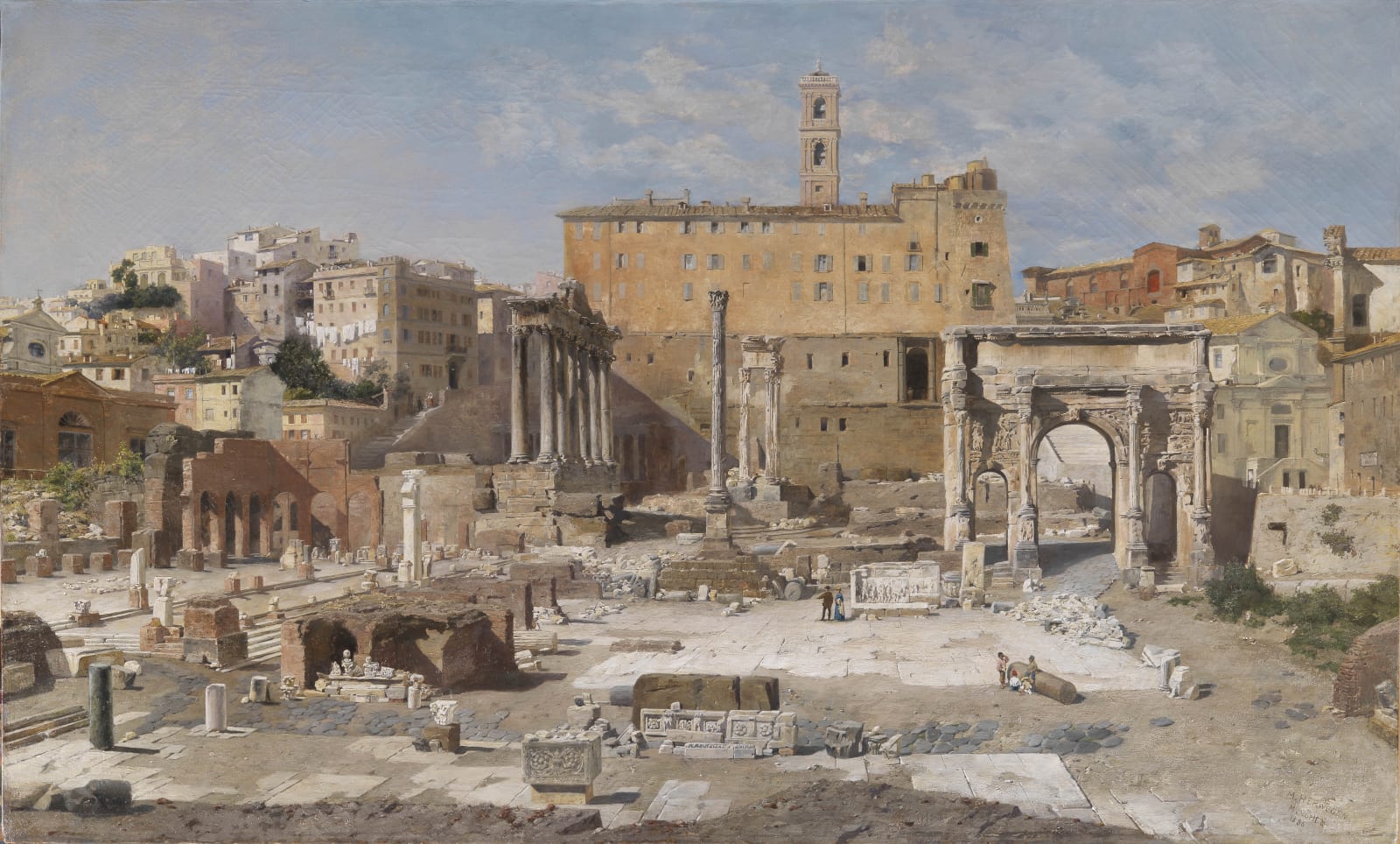Veronika Maria HERWEGEN-MANINI 1851-1933
Provenance
Lempertz, 20 May 2000; from 2002, London, Colnaghi; London, private collection.
Exhibitions
Jubiläumsausstellung, Berlin 1886.
Literature
Friedrich von Boetticher, Malerwerke des neunzehnten Jahrhunderts, Minden, 1974, p. 540, n. 8 (as Das Forum Romanum nach den neuesten Ausgrabungen).
This painting depicts the ruins of the ancient Rome, a subject of which 19th century painters were especially fond, offering us a view of the Roman Forum as it would have looked in 1886. This rare and detailed view of the area in the wake of the archaeological excavations being conducted at the time[1] was painted from a vantage point set deliberately at a higher level than the subject matter, most probably from the podium of the Temple of Julius Caesar.
We can clearly make out the ruins of the ancient Roman buildings in the Forum. From left to right, we see the remains of the Basilica Julia with its porticoes, its steps and one of the Doric half-columns adorning the pilasters on its façade giving onto the Forum. These are preceded by the rostra of the Temple of Julius Caesar, while on the other side of the Basilica, closer to the Capitol, we perceive the ruins of the Temple of Saturn, consisting in its podium, the drums of its grey and pink granite columns with their Ionic capitals and part of its trabeation. The view also shows us see the white marble Corinthian column dedicated to the Byzantine Emperor Phocas, set at no great distance from the three surviving columns of the Temple of Vespasian and the Arch of Septimius Severus with its three archways, while on the far right of the painting we can make out the façade of the church of San Giuseppe dei Falegnami. In the background, hard by the Arch of Septimius Severus, we are also shown the brick façade of the church of Santa Maria in Aracoeli.
In painting this view – almost topographical in its precision, as we can tell by comparing it to photographs taken at the time – the artist appears to be eager to set down on record the changes occurring in the city, pitting the glory of the ancient ruins with the backdrop of the Palatium Senatorium against the houses on the left of the composition (which were to be demolished in the 1930s) packed against the slopes of the Capitol Hill and offering a glimpse of everyday life in the neighbourhood through such charming details as the washing hanging out to dry in the sun.
The artist also breathes life into the glorious remains of the city's Classical past by adopting a still pre-Romantic spirit to depict a couple of illustrious visitors standing close to a fragment of Trajan's plutei, which were unearthed in the area between the Corinthian column and the Column of Phocas in 1872 and later moved to the Basilica Julia.
The painting does not show the road that linked Via Bonella to Piazza della Consolazione from 1839 to 1882, a road commonly seen in the many views of the Roman Forum produced in the middle years of the 19th century which snaked its way on an embankment in an "S" shape from the Arch of Septimius Severus up to the Capitol, forking just above the southern corner of the Temple of Saturn. Minster of Education Guido Baccelli requested that the road be demolished in order to allow the Forum and Capitol to be united again and his wish was granted in 1882, by which time the entire of area at the foothills of the Capitoline Hill had been fully excavated. Local residents, however, protested so strongly that the road was very soon rebuilt (between 1882 and 1888, when it was renamed Via del Foro Romano), its route completely covering the ancient Clivus Capitolinus as it wound its way between the Temple of Saturn and the Temple of the deified Vespasian.
The new road was altered in the 1940s and finally removed altogether in 1981. Thus the German artist's picture appears to have captured the fleeting moment in which the old road had been demolished but the new one had not yet been built, as we can see in the photograph below showing the area at the time, albeit from a different vantage point[2].
JOIN OUR MAILING LIST
Subscribe to our mailing list in order to receive news on new acquisitions, exhibitions, special previews and more!
* denotes required fields
We will process the personal data you have supplied to communicate with you in accordance with our Privacy Policy. You can unsubscribe or change your preferences at any time by clicking the link in our emails.
